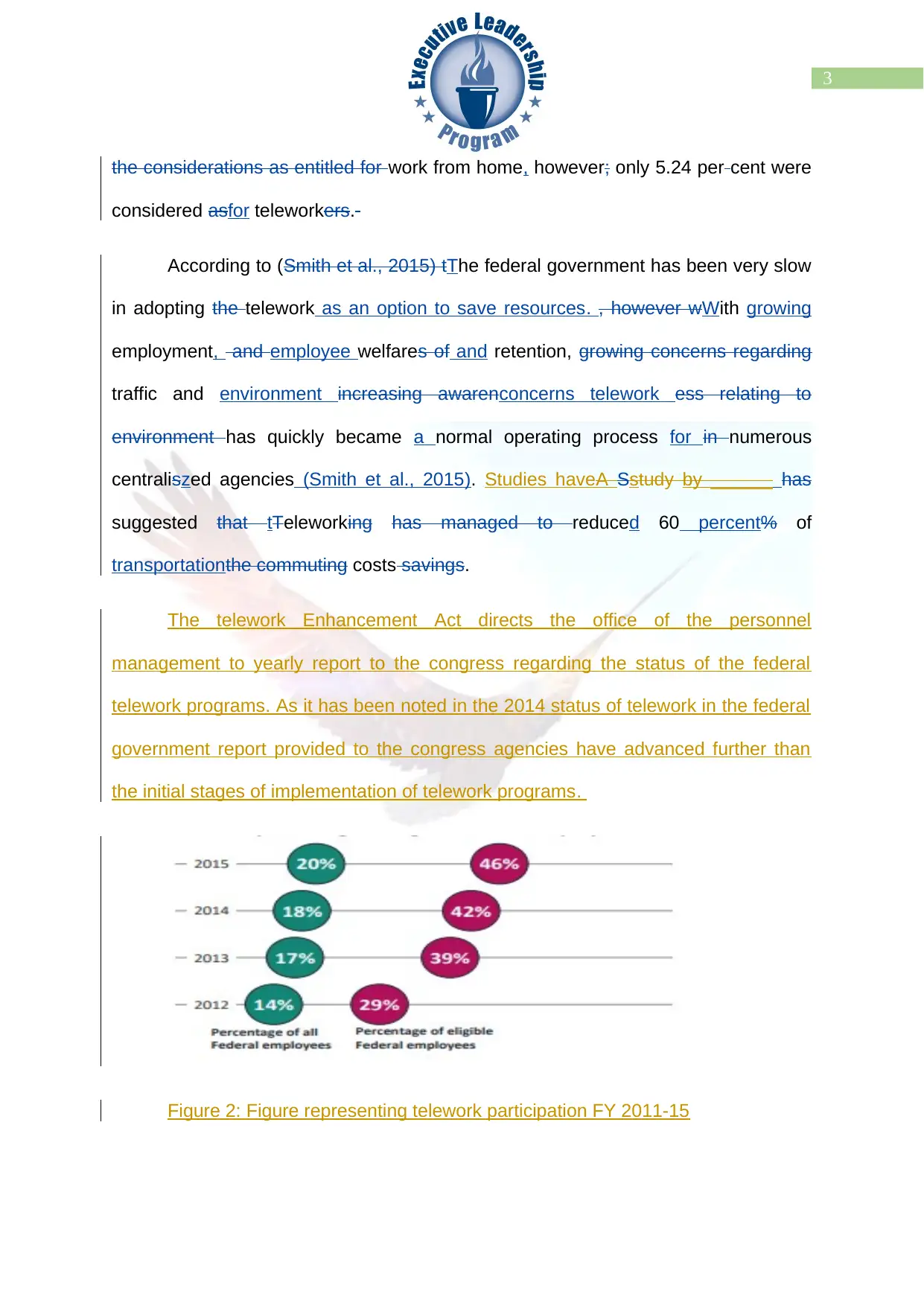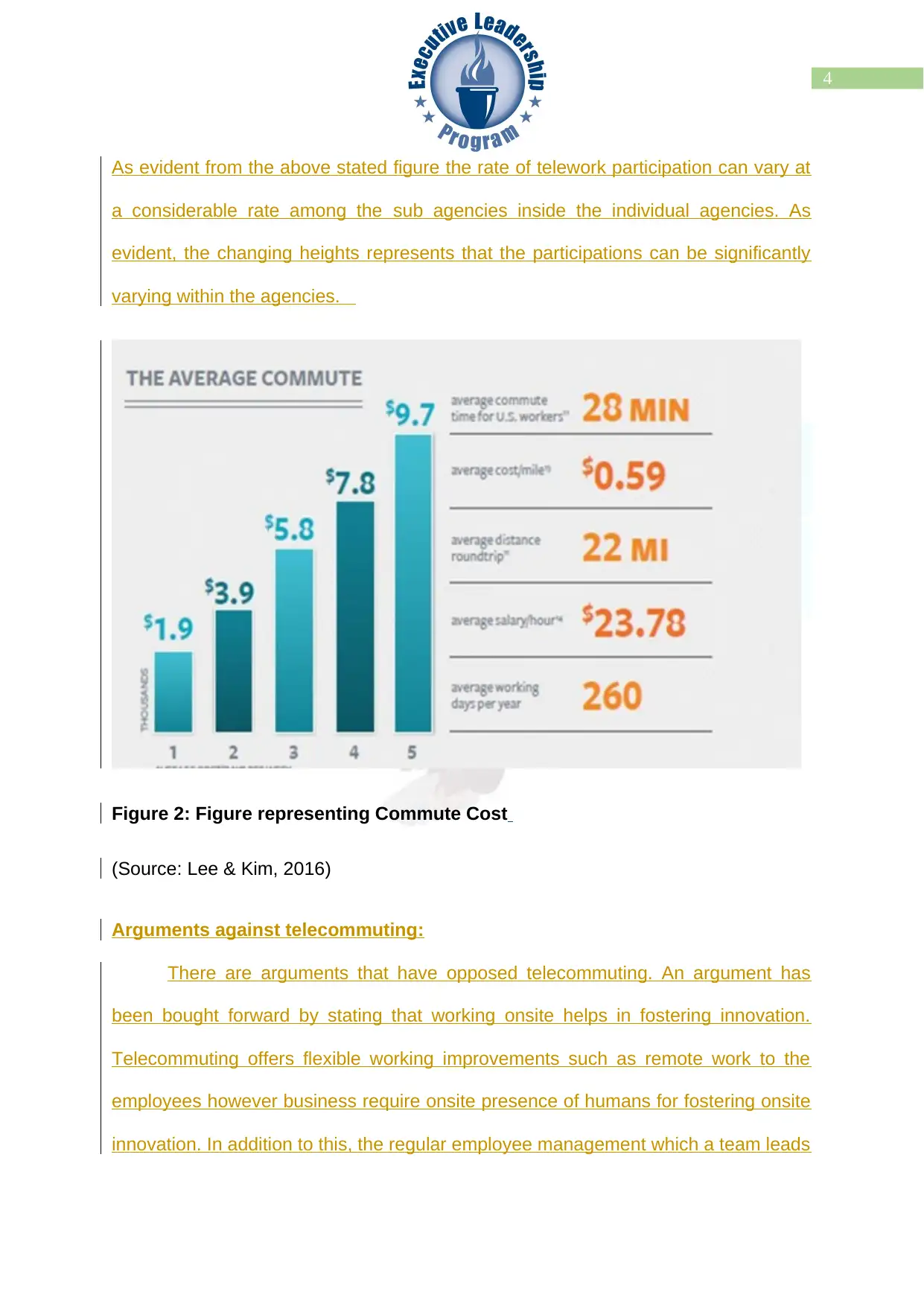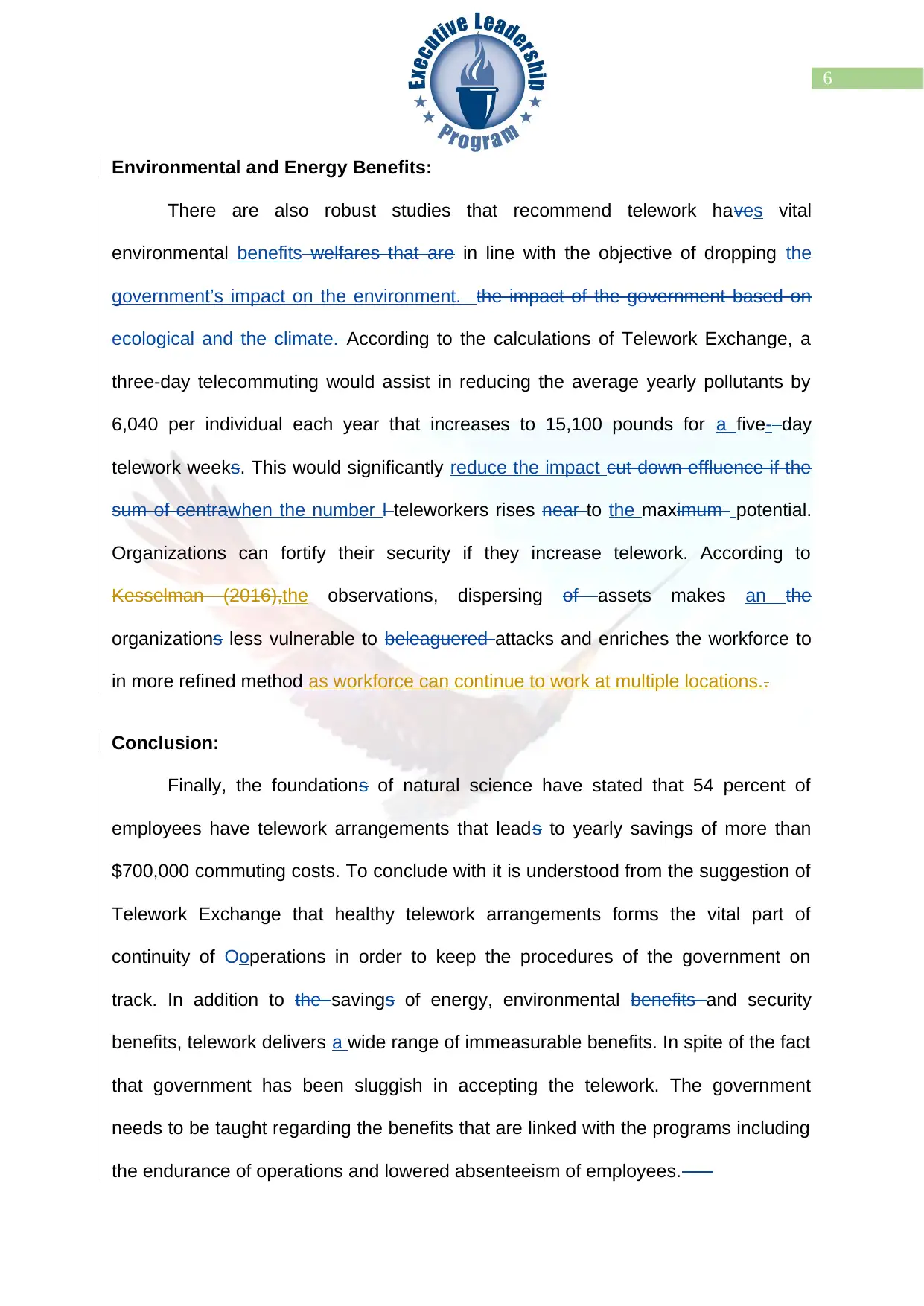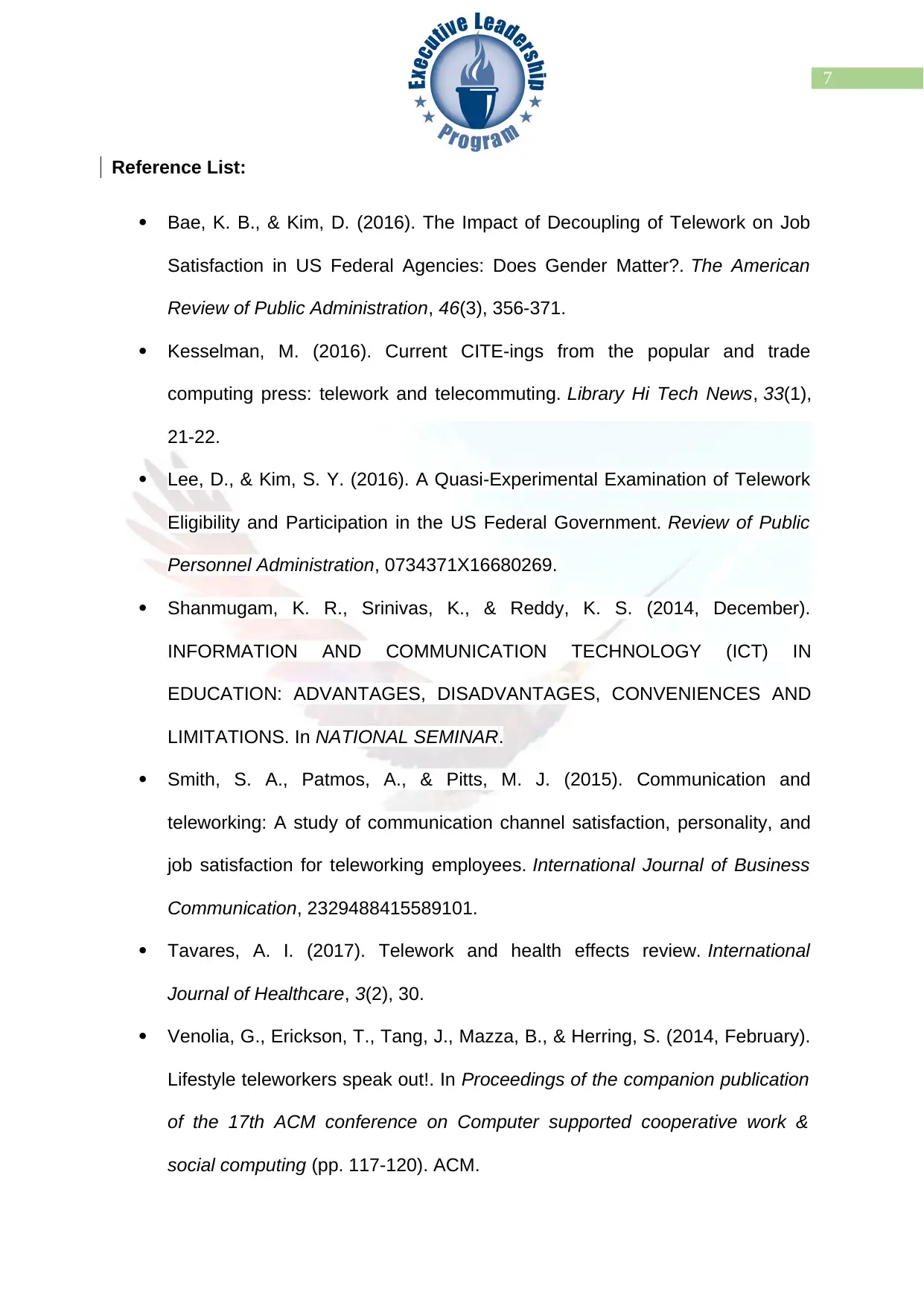Federal Telework Surge: Economic, Environmental, and Security Benefits
VerifiedAdded on 2020/03/04
|9
|1515
|53
Report
AI Summary
This report analyzes the potential benefits of increased telework within the federal government. It highlights the potential for significant economic savings, estimating a possible $14 billion annual reduction in costs through wider adoption of telecommuting. The report also emphasizes the environmental advantages, such as reduced greenhouse gas emissions and lower energy consumption, equivalent to planting millions of trees. Furthermore, it discusses the enhanced security telework can provide by dispersing workers and data, making organizations less vulnerable to attacks. The report addresses arguments against telecommuting, such as the need for on-site innovation and employee management, while also providing statistics on telework participation and cost savings. It concludes by advocating for the further adoption of telework programs, emphasizing the financial, environmental, and security benefits that support the continuity of government operations and improve employee welfare. The report references multiple studies and figures to support its findings.

Running head: Telework Management for Dummies Tool
FEDERAL TELEWORK SURGE COULD SAVE $14 BILLION ANNUALLY
The federal government could approximately save $14 billion yearly, if the
employees who are both attentive and qualified to telework can implement the work
two times in a week (Shanmugam et al., 2016). In newly available reports by the
Global Workplace analytics and Telework Research Network, it stated that a yearly
forecast by promoting government- wide telework could help in savings. The newest
forecast established the likely savings of about $14 billion yearly and cutting down
the release of greenhouse gases is identical to planting of 18 million trees.
Discussion:
Government leaders looks to cut down the consumption of oil and pollution
release and consolidating the nation-wide security. One of the best way of doing this
is by growing the system of telework system. Teleworkers and their employers could
in significant amounts reduce the use of energy and save money (Weinert et al.,
2014). Over the span of a year, the average amount an American can save is around
340 gallons of gas, with more more than $1,000one thousand dollars of cost of in
travelling costs and more than three tons of carbon-dioxide released with the help of
telecommuting. It is noteworthy, to denote that telecommuting helps during natural
disasters by in construction of elasticity during the face of the tragedy by dispersing
workers and data, so business can continue operating. in order to continue the
business and immediate recovery of natural disaster.
FEDERAL TELEWORK SURGE COULD SAVE $14 BILLION ANNUALLY
The federal government could approximately save $14 billion yearly, if the
employees who are both attentive and qualified to telework can implement the work
two times in a week (Shanmugam et al., 2016). In newly available reports by the
Global Workplace analytics and Telework Research Network, it stated that a yearly
forecast by promoting government- wide telework could help in savings. The newest
forecast established the likely savings of about $14 billion yearly and cutting down
the release of greenhouse gases is identical to planting of 18 million trees.
Discussion:
Government leaders looks to cut down the consumption of oil and pollution
release and consolidating the nation-wide security. One of the best way of doing this
is by growing the system of telework system. Teleworkers and their employers could
in significant amounts reduce the use of energy and save money (Weinert et al.,
2014). Over the span of a year, the average amount an American can save is around
340 gallons of gas, with more more than $1,000one thousand dollars of cost of in
travelling costs and more than three tons of carbon-dioxide released with the help of
telecommuting. It is noteworthy, to denote that telecommuting helps during natural
disasters by in construction of elasticity during the face of the tragedy by dispersing
workers and data, so business can continue operating. in order to continue the
business and immediate recovery of natural disaster.
Paraphrase This Document
Need a fresh take? Get an instant paraphrase of this document with our AI Paraphraser

1
Telework or telecommuting provides a significant amount of financial,
environmental and safety benefits. Employees that telework helps to in rreduceing
and
removeing commute times, saves time, and money, lowering pollution.
Additionally, and employers are better able to decrease their office space and cost
of operations. Telecommuting also helps in protecting the society from any kind of
disruptions that occurs from natural disasters or terrorist’s attacks. In spite of the
benefits, telework has to experiences a large number of obstructions from a reluctant
established culture to opposing laws relating to tax (Bae & Kim, 2016). The
government must take simple steps with the objective ofto lowerring or eliminateing
these barriers saving the money of the taxpayers and paving the way for towards a
more agile workforce.
Several groups are looking forward for ways of reducing the America’s use of
energy for numerous different reasons. A large number of them are concerned
aboutregarding the climate change and considered about cutting down the use of
energy as the essential steps in restricting the greenhouse gas emissions (Tavares
2017). Others have citied their concerns regardingabout the safeguarding t of the
environment from the harms that are caused by the production of energy and
distribution of energy. Telecommuting can be basically defined as the dispersed
working. As per the study conducted by the U.S General Services Administration in
2000, telework is a work arrangement in which an employee continuously works at
the substitute worksite namely the home of the employee or a teleworking centre.
Telework or telecommuting provides a significant amount of financial,
environmental and safety benefits. Employees that telework helps to in rreduceing
and
removeing commute times, saves time, and money, lowering pollution.
Additionally, and employers are better able to decrease their office space and cost
of operations. Telecommuting also helps in protecting the society from any kind of
disruptions that occurs from natural disasters or terrorist’s attacks. In spite of the
benefits, telework has to experiences a large number of obstructions from a reluctant
established culture to opposing laws relating to tax (Bae & Kim, 2016). The
government must take simple steps with the objective ofto lowerring or eliminateing
these barriers saving the money of the taxpayers and paving the way for towards a
more agile workforce.
Several groups are looking forward for ways of reducing the America’s use of
energy for numerous different reasons. A large number of them are concerned
aboutregarding the climate change and considered about cutting down the use of
energy as the essential steps in restricting the greenhouse gas emissions (Tavares
2017). Others have citied their concerns regardingabout the safeguarding t of the
environment from the harms that are caused by the production of energy and
distribution of energy. Telecommuting can be basically defined as the dispersed
working. As per the study conducted by the U.S General Services Administration in
2000, telework is a work arrangement in which an employee continuously works at
the substitute worksite namely the home of the employee or a teleworking centre.

2
A portion of federal government has undertaken the issue of telecommuting
before. The present authorization for telecommuting in the executive branch of the
federal government needs an agency to create a policy under which the eligible
employees might participate in telecommuting.
Figure 1: Teleworking in USA
Source: (Bae & Kim, 2016)
Estimations generally vary mostly in regard to the study technique used and
entities inspected, there is are ample of room for growth in the government
telecommuting. As evident in United States, the public segment usually offers job to
around 15 per cent of the population in the year 2001 (Tavares, 2017). As per the
reports published in 2009 on teleworking, in it has been established that 78seventy-
eight federal agencies around 60 per cent of the employees are eligible to taken into
A portion of federal government has undertaken the issue of telecommuting
before. The present authorization for telecommuting in the executive branch of the
federal government needs an agency to create a policy under which the eligible
employees might participate in telecommuting.
Figure 1: Teleworking in USA
Source: (Bae & Kim, 2016)
Estimations generally vary mostly in regard to the study technique used and
entities inspected, there is are ample of room for growth in the government
telecommuting. As evident in United States, the public segment usually offers job to
around 15 per cent of the population in the year 2001 (Tavares, 2017). As per the
reports published in 2009 on teleworking, in it has been established that 78seventy-
eight federal agencies around 60 per cent of the employees are eligible to taken into
⊘ This is a preview!⊘
Do you want full access?
Subscribe today to unlock all pages.

Trusted by 1+ million students worldwide

3
the considerations as entitled for work from home, however; only 5.24 per cent were
considered asfor teleworkers.
According to (Smith et al., 2015) tThe federal government has been very slow
in adopting the telework as an option to save resources. , however wWith growing
employment, and employee welfares of and retention, growing concerns regarding
traffic and environment increasing awarenconcerns telework ess relating to
environment has quickly became a normal operating process for in numerous
centraliszed agencies (Smith et al., 2015). Studies haveA Sstudy by ______ has
suggested that tTeleworking has managed to reduced 60 percent% of
transportationthe commuting costs savings.
The telework Enhancement Act directs the office of the personnel
management to yearly report to the congress regarding the status of the federal
telework programs. As it has been noted in the 2014 status of telework in the federal
government report provided to the congress agencies have advanced further than
the initial stages of implementation of telework programs.
Figure 2: Figure representing telework participation FY 2011-15
the considerations as entitled for work from home, however; only 5.24 per cent were
considered asfor teleworkers.
According to (Smith et al., 2015) tThe federal government has been very slow
in adopting the telework as an option to save resources. , however wWith growing
employment, and employee welfares of and retention, growing concerns regarding
traffic and environment increasing awarenconcerns telework ess relating to
environment has quickly became a normal operating process for in numerous
centraliszed agencies (Smith et al., 2015). Studies haveA Sstudy by ______ has
suggested that tTeleworking has managed to reduced 60 percent% of
transportationthe commuting costs savings.
The telework Enhancement Act directs the office of the personnel
management to yearly report to the congress regarding the status of the federal
telework programs. As it has been noted in the 2014 status of telework in the federal
government report provided to the congress agencies have advanced further than
the initial stages of implementation of telework programs.
Figure 2: Figure representing telework participation FY 2011-15
Paraphrase This Document
Need a fresh take? Get an instant paraphrase of this document with our AI Paraphraser

4
As evident from the above stated figure the rate of telework participation can vary at
a considerable rate among the sub agencies inside the individual agencies. As
evident, the changing heights represents that the participations can be significantly
varying within the agencies.
Figure 2: Figure representing Commute Cost
(Source: Lee & Kim, 2016)
Arguments against telecommuting:
There are arguments that have opposed telecommuting. An argument has
been bought forward by stating that working onsite helps in fostering innovation.
Telecommuting offers flexible working improvements such as remote work to the
employees however business require onsite presence of humans for fostering onsite
innovation. In addition to this, the regular employee management which a team leads
As evident from the above stated figure the rate of telework participation can vary at
a considerable rate among the sub agencies inside the individual agencies. As
evident, the changing heights represents that the participations can be significantly
varying within the agencies.
Figure 2: Figure representing Commute Cost
(Source: Lee & Kim, 2016)
Arguments against telecommuting:
There are arguments that have opposed telecommuting. An argument has
been bought forward by stating that working onsite helps in fostering innovation.
Telecommuting offers flexible working improvements such as remote work to the
employees however business require onsite presence of humans for fostering onsite
innovation. In addition to this, the regular employee management which a team leads

5
deals with carry plenty of additional baggage which needs managing. Having remote
workers results in potential problems for the management in managing a team in the
entire room. Therefore, having an onsite worker helps is easier to manage.
Additionally, there are some people that cannot telecommute and possess
necessary combination of skills to successfully work in the office. As a result of this
communication becomes easier in the office and an individual can communicate less
effectively with their peers.
Economic benefits:
Telework has provided many possible economic benefits for the workers and
employers. Telework eEExchange figures $9,796 is the the normal annual cost of
travelling as $9,796 for five days a week, however only $3,918 is incurred for three
day telework schedule saving workers which in turn provides savings to workers of
$5,878 (Venolia et al., 2014). The federal government would save $13.9 billion if 79
percent of government workers could telework full time.
The government is not just ignoring the potential benefits of telework. If those
savings are added up given that, the 79 per cent of the central workers does
telework in full time they would be able to save around $13.9 billion in traveling cost
yearly. It can be said that the government has totally not been indolent concerning
telework. The fFour centerscentresres of the General Service Administration general
service administrations save employees $500 each year for two days of teleworking
just one or two of telework each week.
deals with carry plenty of additional baggage which needs managing. Having remote
workers results in potential problems for the management in managing a team in the
entire room. Therefore, having an onsite worker helps is easier to manage.
Additionally, there are some people that cannot telecommute and possess
necessary combination of skills to successfully work in the office. As a result of this
communication becomes easier in the office and an individual can communicate less
effectively with their peers.
Economic benefits:
Telework has provided many possible economic benefits for the workers and
employers. Telework eEExchange figures $9,796 is the the normal annual cost of
travelling as $9,796 for five days a week, however only $3,918 is incurred for three
day telework schedule saving workers which in turn provides savings to workers of
$5,878 (Venolia et al., 2014). The federal government would save $13.9 billion if 79
percent of government workers could telework full time.
The government is not just ignoring the potential benefits of telework. If those
savings are added up given that, the 79 per cent of the central workers does
telework in full time they would be able to save around $13.9 billion in traveling cost
yearly. It can be said that the government has totally not been indolent concerning
telework. The fFour centerscentresres of the General Service Administration general
service administrations save employees $500 each year for two days of teleworking
just one or two of telework each week.
⊘ This is a preview!⊘
Do you want full access?
Subscribe today to unlock all pages.

Trusted by 1+ million students worldwide

6
Environmental and Energy Benefits:
There are also robust studies that recommend telework haves vital
environmental benefits welfares that are in line with the objective of dropping the
government’s impact on the environment. the impact of the government based on
ecological and the climate. According to the calculations of Telework Exchange, a
three-day telecommuting would assist in reducing the average yearly pollutants by
6,040 per individual each year that increases to 15,100 pounds for a five- day
telework weeks. This would significantly reduce the impact cut down effluence if the
sum of centrawhen the number l teleworkers rises near to the maximum potential.
Organizations can fortify their security if they increase telework. According to
Kesselman (2016),the observations, dispersing of assets makes an the
organizations less vulnerable to beleaguered attacks and enriches the workforce to
in more refined method as workforce can continue to work at multiple locations..
Conclusion:
Finally, the foundations of natural science have stated that 54 percent of
employees have telework arrangements that leads to yearly savings of more than
$700,000 commuting costs. To conclude with it is understood from the suggestion of
Telework Exchange that healthy telework arrangements forms the vital part of
continuity of Ooperations in order to keep the procedures of the government on
track. In addition to the savings of energy, environmental benefits and security
benefits, telework delivers a wide range of immeasurable benefits. In spite of the fact
that government has been sluggish in accepting the telework. The government
needs to be taught regarding the benefits that are linked with the programs including
the endurance of operations and lowered absenteeism of employees.
Environmental and Energy Benefits:
There are also robust studies that recommend telework haves vital
environmental benefits welfares that are in line with the objective of dropping the
government’s impact on the environment. the impact of the government based on
ecological and the climate. According to the calculations of Telework Exchange, a
three-day telecommuting would assist in reducing the average yearly pollutants by
6,040 per individual each year that increases to 15,100 pounds for a five- day
telework weeks. This would significantly reduce the impact cut down effluence if the
sum of centrawhen the number l teleworkers rises near to the maximum potential.
Organizations can fortify their security if they increase telework. According to
Kesselman (2016),the observations, dispersing of assets makes an the
organizations less vulnerable to beleaguered attacks and enriches the workforce to
in more refined method as workforce can continue to work at multiple locations..
Conclusion:
Finally, the foundations of natural science have stated that 54 percent of
employees have telework arrangements that leads to yearly savings of more than
$700,000 commuting costs. To conclude with it is understood from the suggestion of
Telework Exchange that healthy telework arrangements forms the vital part of
continuity of Ooperations in order to keep the procedures of the government on
track. In addition to the savings of energy, environmental benefits and security
benefits, telework delivers a wide range of immeasurable benefits. In spite of the fact
that government has been sluggish in accepting the telework. The government
needs to be taught regarding the benefits that are linked with the programs including
the endurance of operations and lowered absenteeism of employees.
Paraphrase This Document
Need a fresh take? Get an instant paraphrase of this document with our AI Paraphraser

7
Reference List:
Bae, K. B., & Kim, D. (2016). The Impact of Decoupling of Telework on Job
Satisfaction in US Federal Agencies: Does Gender Matter?. The American
Review of Public Administration, 46(3), 356-371.
Kesselman, M. (2016). Current CITE-ings from the popular and trade
computing press: telework and telecommuting. Library Hi Tech News, 33(1),
21-22.
Lee, D., & Kim, S. Y. (2016). A Quasi-Experimental Examination of Telework
Eligibility and Participation in the US Federal Government. Review of Public
Personnel Administration, 0734371X16680269.
Shanmugam, K. R., Srinivas, K., & Reddy, K. S. (2014, December).
INFORMATION AND COMMUNICATION TECHNOLOGY (ICT) IN
EDUCATION: ADVANTAGES, DISADVANTAGES, CONVENIENCES AND
LIMITATIONS. In NATIONAL SEMINAR.
Smith, S. A., Patmos, A., & Pitts, M. J. (2015). Communication and
teleworking: A study of communication channel satisfaction, personality, and
job satisfaction for teleworking employees. International Journal of Business
Communication, 2329488415589101.
Tavares, A. I. (2017). Telework and health effects review. International
Journal of Healthcare, 3(2), 30.
Venolia, G., Erickson, T., Tang, J., Mazza, B., & Herring, S. (2014, February).
Lifestyle teleworkers speak out!. In Proceedings of the companion publication
of the 17th ACM conference on Computer supported cooperative work &
social computing (pp. 117-120). ACM.
Reference List:
Bae, K. B., & Kim, D. (2016). The Impact of Decoupling of Telework on Job
Satisfaction in US Federal Agencies: Does Gender Matter?. The American
Review of Public Administration, 46(3), 356-371.
Kesselman, M. (2016). Current CITE-ings from the popular and trade
computing press: telework and telecommuting. Library Hi Tech News, 33(1),
21-22.
Lee, D., & Kim, S. Y. (2016). A Quasi-Experimental Examination of Telework
Eligibility and Participation in the US Federal Government. Review of Public
Personnel Administration, 0734371X16680269.
Shanmugam, K. R., Srinivas, K., & Reddy, K. S. (2014, December).
INFORMATION AND COMMUNICATION TECHNOLOGY (ICT) IN
EDUCATION: ADVANTAGES, DISADVANTAGES, CONVENIENCES AND
LIMITATIONS. In NATIONAL SEMINAR.
Smith, S. A., Patmos, A., & Pitts, M. J. (2015). Communication and
teleworking: A study of communication channel satisfaction, personality, and
job satisfaction for teleworking employees. International Journal of Business
Communication, 2329488415589101.
Tavares, A. I. (2017). Telework and health effects review. International
Journal of Healthcare, 3(2), 30.
Venolia, G., Erickson, T., Tang, J., Mazza, B., & Herring, S. (2014, February).
Lifestyle teleworkers speak out!. In Proceedings of the companion publication
of the 17th ACM conference on Computer supported cooperative work &
social computing (pp. 117-120). ACM.

8
Weinert, C., Maier, C., Laumer, S., & Weitzel, T. (2014, May). Does
teleworking negatively influence IT professionals?: an empirical analysis of IT
personnel's telework-enabled stress. In Proceedings of the 52nd ACM
conference on Computers and people research (pp. 139-147). ACM.
Weinert, C., Maier, C., Laumer, S., & Weitzel, T. (2014, May). Does
teleworking negatively influence IT professionals?: an empirical analysis of IT
personnel's telework-enabled stress. In Proceedings of the 52nd ACM
conference on Computers and people research (pp. 139-147). ACM.
⊘ This is a preview!⊘
Do you want full access?
Subscribe today to unlock all pages.

Trusted by 1+ million students worldwide
1 out of 9
Your All-in-One AI-Powered Toolkit for Academic Success.
+13062052269
info@desklib.com
Available 24*7 on WhatsApp / Email
![[object Object]](/_next/static/media/star-bottom.7253800d.svg)
Unlock your academic potential
Copyright © 2020–2025 A2Z Services. All Rights Reserved. Developed and managed by ZUCOL.

